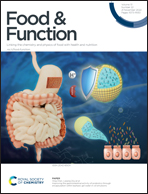Chemical composite of indigenous whole grain scented joha rice varietal prevents type 2 diabetes in rats through ameliorating insulin sensitization by the IRS-1/AKT/PI3K signalling cascade†
Abstract
Preventive measures to lower the prevalence of type-2 diabetes development using dietary phytochemicals are most realistic. A phytochemical composite derived from whole grain scented joha rice (PCKJ), which is indigenous to the North-eastern Region, India, was investigated to understand its preventive efficacy in rats in which type 2 diabetes was induced using a high-fat high-fructose (HFHF) diet and a low dose of streptozotocin, and the findings were correlated with those in L6-myotubes. Studies on cultured L6 myotubes revealed that treatment with PCKJ facilitated glucose uptake and GLUT-4 translocation to the plasma membrane, as evidenced by confocal microscopy and/or cell fractionation studies. Furthermore, the FFA-induced L6 myotubes were identified as having elevated levels of PI3K, p-AKT (Ser473) and GLUT-4, which returned to the basal level upon exposure to PCKJ. The administration of PCKJ (100 mg per kg body weight, oral gavage, 24 weeks) to rats significantly reduced their blood glucose levels along with common lipid and liver biomarkers (LDL, triglycerides, cholesterol, ALT, and AST) compared to the control group. Moreover, immunoblotting analysis showed that upon PCKJ treatment, PI3K, p-AKT and GLUT-4 levels are upregulated in the skeletal tissue of HFHF-fed rats, similar to the in vitro model. The alteration in the levels of inflammatory cytokines IL-6, IL-10 and IFN-γ in diabetic rats returned to normal levels upon exposure to PCKJ. Histological analysis of vital tissues further strengthens the findings of the preventive value of PCKJ against the development of insulin resistance. In conclusion, this study showed the prophylactic effect of PCKJ as a potent chemical composite, which can be used to develop functional foods (nutraceuticals) for ameliorating type-2 diabetes by improving insulin sensitization and thereby glucose metabolism.



 Please wait while we load your content...
Please wait while we load your content...